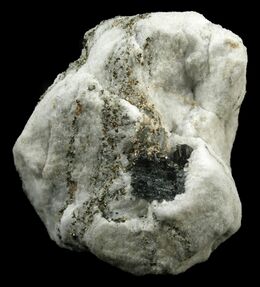Chemistry:Sartorite
From HandWiki
Short description: Lead arsenic sulfide
| Sartorite | |
|---|---|
 | |
| General | |
| Category | Satorite Group |
| Formula (repeating unit) | PbAs2S4 |
| Strunz classification | 2.HC.05a |
| Dana classification | 3.7.8.1 |
| Crystal system | Monoclinic |
| Crystal class | Prismatic |
| Space group | P21/c (no. 14) |
| Unit cell | 648.62 ų |
| Identification | |
| Colour | Grey |
| Cleavage | Imperfect/Fair |
| Fracture | Conchoidal |
| Tenacity | Very brittle |
| Mohs scale hardness | 3 |
| |re|er}} | Metallic |
| Streak | chocolate-brown |
| Diaphaneity | Opaque |
| Specific gravity | 5.08 - 5.12 |
| Density | 5.08 - 5.12 g/cm3 |
| Pleochroism | Weak |
Sartorite is a lead arsenic sulfide with the chemical formula PbAs2S4 and as type locality the Lengenbach Quarry in Legenbach, Binnental, Valais, Switzerland .[2][3] Historically, sartorite has been thought isomorphic to chalcostibite, emplectite, and zinckenite, but was definitively distinguished from the others in 1939.[4]
Etymology
The mineral is named after its discoverer, Sartorius von Walterhausen (1809-1876).[5]
Occurrences
The mineral is predominantly found in hydrothermal deposits in dolomite. Sometimes the mineral is containing traces of thallium and has been reported from:[2]
- Argentina
- Jujuy Province
- Rinconada Department
- Rinconada
- Cerro Redondo prospect
- Rinconada
- Rinconada Department
- Jujuy Province
- Austria
- Tyrol
- North Tyrol
- Inn valley
- Hall
- Hall valley
- Salt mine
- Hall valley
- North Tyrol
- Tyrol
- Azerbaijan
- Balakan District
- Belokan-Avar ore district
- Filizchai deposit
- Belokan-Avar ore district
- Balakan District
- China
- Hunan
- Huaihua
- Huitong Co.
- Mobin Au deposit (Unconfirmed)[6]
- Huitong Co.
- Huaihua
- Hunan
- Hungary
- Pest County
- Szob District
- Nagybörzsöny
- Szob District
- Pest County
- Italy
- Tuscany
- Lucca Province
- Seravezza
- Seravezza quarrying basin
- Seravezza
- Lucca Province
- Tuscany
- Japan
- Hokkaidō
- Abuta District
- Takarada
- Tohya mine (Toya mine; Tohya-Takarada mine) ?
- Takarada
- Abuta District
- Hokkaidō
- Spain
- Andalusia
- Granada
- Baza
- Sierra de Baza
- Calar de San José
- Sierra de Baza
- Baza
- Granada
- Andalusia
- Switzerland
- Valais
- Binn Valley
- Binn
- Reckibach
- Lengenbach Quarry (TL)
- Messerbach (Mässerbach)
- Reckibach
- Binn
- Binn Valley
- Valais
- United States
- Colorado
- San Juan Co.
- Red Mountain Mining District
- Anvil Mountain
- Zuñi mine
- Anvil Mountain
- Red Mountain Mining District
- San Juan Co.
- New York
- St. Lawrence Co.
- Fowler
- Sylvia Lake
- Balmat mine
- Sylvia Lake
- Fowler
- St. Lawrence Co.
- Colorado
See also
References
- ↑ Warr, L.N. (2021). "IMA–CNMNC approved mineral symbols". Mineralogical Magazine 85 (3): 291–320. doi:10.1180/mgm.2021.43. Bibcode: 2021MinM...85..291W.
- ↑ 2.0 2.1 "Sartorite". https://www.mindat.org/min-3537.html.
- ↑ "THE MINERAL SARTORITE". Amethyst Galleries. http://www.galleries.com/Sartorite.
- ↑ Bannister; Pabst, Adolf; Vaux, George (1939). "The crystallography of sartorite". Mineralogical Magazine and Journal of the Mineralogical Society 25 (164): 264–270. doi:10.1180/minmag.1939.025.164.05. Bibcode: 1939MinM...25..264B.
- ↑ Sartorite at Webmineral.com
- ↑ "Sartorite from Mobin Au deposit, Huitong Co., Huaihua, Hunan, China". https://www.mindat.org/locentry-870343.html.
Further reading
- Kharbish, S. (2016) Micro‐Raman spectroscopic investigations of extremely scarce Pb–As sulfosalt minerals: baumhauerite, dufrénoysite, gratonite, sartorite, and seligmannite. Journal of Raman Spectroscopy 47, 1360-1366
- Cannon, R., Hensel, H. & Raber, T. (2008): Der Reckibach-Dolomit im Binntal, Schweiz: Mineralbestand und Neufunde. Lapis, 33 (3), 20–28; 50. (in German); Lapis No. 3, March
- Rocks & Minerals 71:2 pp. 94–101, New York
- U.S. Geological Survey, 2005, Mineral Resources Data System: U.S. Geological Survey, Reston, Virginia
- Berlepsch, P., Armbruster, T., Makovicky, E., Topa, D. (2003) Another step toward understanding the true nature of sartorite: Determination and refinement of a ninefold superstructure. Am. Mineral. 88, 450–461. [= enneasartorite]
- Stalder, H. A., Wagner, A., Graeser, S. and Stuker, P. (1998): "Mineralienlexikon der Schweiz", Wepf (Basel), p. 361
- Shimizu & Matsuyama (1997) Ganko-Gakkai Kou'en-Youshi, 160
- Pring, A. (1995) Structural modulation in sartorite: An electron microscopy study. Am. Mineral. 78, 619–626.
- Sureda, R.J., Brito, J.R. (1992) Sartorita, PbAs2S4, en el prospecto polimetalico cerro Redondo, Jujuy, Argentina. 1 Reunion de Mineralogia y Metalogenia. Instituto de Recursos Minerales. UNLP Publicacion 2:307-318.; Milka K. de Brodtkorb (2002) Las Especies Minerales de la Republica Argentina. Vol. 1 (elements, sulphides and sulphosalts). (Asociacion Mineralogica Argentina)
- Dezhong Zhou, Dayuan Ye, and Dalong Yu (1989): Mineral Deposits 8(1), 51-64
- Torres-Ruis, J., Velilla, N., Vivaldi, M., Manuel, J., Delgado Salazar, F., & Fenoll Hach-Ali, P. (1985). The fluorite-(Ba-Pb-Zn) deposits of the" Sierra de Baza"(Betic Cordillera, South-East Spain). Bulletin de minéralogie, 108(3), 421-436
- Koch: Minerals of Hungary, 1985
- Canadian Mineralogist (1980) 18:13-15; Orlandi, P. & Criscuolo, A. (2009). Minerali del marmo delle Alpi Apuane. Pacini editore, Pisa, 180 pp.
- Iitaka, Y. & Nowacki, W. (1961) A refinement of the pseudo crystal structure of scleroclase PbAs2S4. Acta Crystallographica 14, 1291-1292
- Palache, Charles, Harry Berman & Clifford Frondel (1944) The System of Mineralogy of James Dwight Dana and Edward Salisbury Dana Yale University 1837–1892, Volume I: Elements, Sulfides, Sulfosalts, Oxides. John Wiley and Sons, Inc., New York. 7th edition, revised and enlarged: 478-481
- Smith, G.F.H. and Solly, R.H. (1919) On sartorite and the problem of its crystal-form. Mineral. Mag., 18, 259-316
 |

